JAPANESE FADS

winged Ultraman van The Japanese always seem to be in the grip of one fad or another. There is an expression that Japanese people become instantly hot and instantly cold, meaning they get excited about something very quickly and get bored of it just as fast.
Fads come and go with amazing speed and variety. Japan has been described as a "media saturated country where new ideas and fashions spread the length of the land in the blink of an eye." One Japanese socialist has suggested that this trendiness is a product of the Japanese fondness for fresh food like raw fish.
Many fads occur spontaneously but are some are carefully constructed by companies like Sony or Nintendo, who are constantly developing new gadgets and characters and cultivating an audience for them. Pokemon and Tamagotchi are most obvious examples of this.
Pop culture sources: Giant Robot, an Asian-American pop culture magazine; Shift, a Tokyo-based online magazine.
Links in this Website: FASHION IN JAPAN Factsanddetails.com/Japan ; KAWAII, GOSU-RORI, AND STREET FASHION IN JAPAN Factsanddetails.com/Japan ; POKEMON, YU GI OH AND MUSHI KING Factsanddetails.com/Japan ; JAPANESE GIRLS AND YOUNG WOMEN Factsanddetails.com/Japan ; JAPANESE TEENAGERS AND YOUNG ADULTS Factsanddetails.com/Japan
Good Websites and Sources: Japanese Fads in the 1990s topics-mag.com ; The Japan Fad in Global Youth Culture muse.jhu.edu/journals/mechademia ; Essay on Japan Cool aboutjapan.japansociety.org ; Cool Japan TV show nhk.or.jp/cooljapan ; Gross National Cool Foreign Policy Magazine ; Cool Japan Project mit.edu/condry
Hello Kitty Home of Hello Kitty sanrio.com ; Hello Kitty Hell kittyhell.com ; Dream Kitty dreamkitty.com ; Book on Hello Kitty atimes.com/atimes ; The Cat Has No Mouth chanpon.org/archive/ Surfing: Websites: Japan Surf Japan Surf ; Global Surfer Report on Japan Global Surfer ; Tokyo Area Surfing jciti.com/jLinks
Pop Culture in Modern Japan
Japan has a rich modern culture: manga, anime, fashion, film, video games, robots, J-pop music, electronic music, modern art, cell phone art, graphics, sound and light shows, Wii consoles and dance machines. Revenues from the sales and royalties of music, video games, anime, art, films and fashion reached $12.5 billion in 2002, an increase of 300 percent from 1992.
Identifying Japan as an emerging cultural “soft power,” Douglas McGray wrote in the May/June 2002 issue of Foreign Policy magazine, “From pop music to consumer electronics, architecture, and animation to cuisine, Japan looks...like a cultural superpower.” McGray described the phenomena as the “gross national cool.” Harvard Professor Joseph Nye, the person coined the term “soft power” was mentioned as a possible ambassador to Japan under U.S. President Barrak Obama.
The market in Japan is so big and lucrative that trendsetters often don’t concern themselves with the expensive, complex task of marketing overseas. Culture trends change very quickly in Japan, more so than the United States. Many Japanese cultural phenomena have not exported well in monetary terms, inspiring fascination and curiosity but not generating sales.
Japanese pop culture has traditionally been controlled by large companies but that is changing. A successful Tokyo graphic designer told Foreign Policy, “Good art is appearing, young strong art. Young fashion is appearing. A lot of interesting smaller magazines have appeared...A lot of small little business, people running their own shops, people running their own music labels.”
Books: “Encyclopedia of Japanese Pop Culture” by Mark Schilling; “Eastern Standard Time: A Guide on Asian Influence on American Culture From Astro By to Zen Buddhism” by Jeff Yang; “Japan Edge: The Insider's Guide to Japanese Pop Subculture” (Cadence Books, 1999) with essays on anime, manga and cyber realms.
Japan Cool and Fantasy Culture
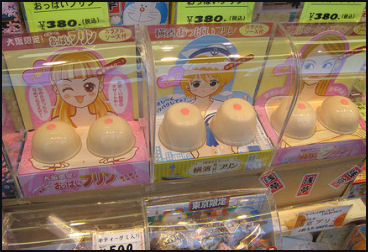
sweet breast pudding “Japan cool” is a term that describes popular, modern Japanese culture particularly in the form of manga, anime, otaku culture and fashion. It has also come to embrace the novels of Haruki Murakami, the pop art of Takashi Murakami and Japanese-produced video games. Murakami and acclaimed animator Hayao Miyazaki reportedly both hate the term "Cool Japan"
The Japanese government has issued orders to private sector to exploit Japanese cool and make as much money from it as possible. One of the objectives was for fashion and clothing companies to exploit certain styles promoted in certain Japanese magazines that are popular in China and Asia. As it stands now Hollywood and American publishers arguably make more money from anime and manga in the United States than Japanese companies do.
Japan is also a place where people dress and act like their favorite manga characters and live out their sexual fantasies in places call image rooms. A 27-year-old American who works in a “butler” café for women told AFP, “Japan has a huge fantasy culture. They often want to escape from daily life and they are good at engineering alternative reality.”
Even with all this Japan has been eclipsed by China as the happening place in Asia. The number of students studying Japanese language and Japanese culture is declining. In Europe, Japanese studies programs are being axed or reduced or absorbed into Asian studies programs at many universities. In the United States, Chinese has clearly became the language and culture of choice. One of the few places where interest in Japan is growing is Russia.
Government Support of Japan Cool
In April 2010, the Japanese government said it would promote “Cool Japan” culture by funding promotional events for Japanese fashion and lifestyle in major cities and creating a public investment fund to support the manga, anime, fashion and video games industries. In December 2010, the Japanese government panel in change of “Cool Japan strategy” said it hopes to generate ¥12 trillion to ¥17 trillion by exporting Japan anime, manga, fashion, food and culture products in the coming years.
In its “strategy to promote culture-oriented industry” the Japanese government has called for an integrated support system — from product development to the signing of overseas sales deals — for small and mid-size companies that lack expertise and funds needed to develop their business abroad.
There seems to be a lack of strategy on how to cash in on the “Japan Cool” phenomena. There is for example a lack of merchandising to ride the popularity of manga and anime characters and a lack of capitalizing on interest in Japanese culture to market Japanese fashions, movies and food. Some have argued that the Japanese government has not helped matters much as its promotion efforts are divided among at least three government ministries.
Cool Japan' Channel in Southeast Asia
In January 2013, Yuki Sato wrote in the Yomiuri Shimbun: “Japanese TV stations, advertising agencies and other partners plan to establish TV stations that broadcast Japanese dramas, anime and information programs in Southeast Asian countries starting this year, a project that could generate an economic bonanza for this country. The Japanese companies will contribute capital and programs to the stations, tentatively named "Japan Channel." The Japanese government will provide financial assistance through a fund tentatively named "Cool Japan Fund," which will be jointly established by the public and private sectors this autumn. [Source: Yuki Sato, Yomiuri Shimbun, January 7, 2013]
Under the plan, a local cable TV station established in Singapore in 2011 with contributions from NTV, TBS and other firms will start airing programs in February. The Singapore station will air Japanese dramas, anime, food shows and other programs. The Japanese government will indirectly help the project through such means as providing subsidies for dubbing and subtitles. The fund, which will be established with about 80 billion yen, will provide funding and management assistance to the station.
To expand areas where broadcasts will be available, the Japan side is coordinating a plan in which Japanese anime production firms, TV stations, advertising agencies and other entities will contribute several billion yen to the fund to establish special purpose companies (SPCs) in different countries to manage local TV stations. The Japan side plans to establish SPCs in Indonesia, the Philippines and other countries in the region and make other preparations to gradually start broadcasting.
Through the channels, Japanese TV programs will be aired intensively, and sales and distribution channels for such Japanese products as toys, cosmetics, clothing and accessories related to the TV programs will be established. South Korea, which Japan sees as a rival in this field, has been enthusiastically conducting its "Cool Korea" campaign since 1997. The South Korean government has played a leading role in promoting South Korean TV dramas, pop music and other cultural products overseas. This has helped improve the image of South Korean products in general and increased foreign tourists to the country.
In 2011, the market for content and products related to "Cool Japan" was about 2.3 trillion yen. The Japanese government aims to expand this to up to 11 trillion yen by 2020, and to 17 trillion yen if sales of Japanese food are included. Seigou Matsuoka, president of the Editorial Engineering Laboratory, said: "It's necessary to link Japan's particular culture with products and industries to increase exports and lure more tourists. I want the government to formulate strategies and circulate money in the necessary places.”
Galapagos Syndrome
Japan's "Galapagos syndrome," a phrase first coined to characterize the nation's highly evolved but globally incompatible cell phones, is lately being applied to other isolated industries, even to its people. "The Galapagosization of Japan continues," trumpeted one U.S. newspaper in the autumn of 2010, when a survey of Japan's white-collar workers revealed that a full two-thirds of them never want to work abroad. [Source: Roland Kelts, Daily Yomiuri, October 29, 2010]
Roland Kelts wrote in the Daily Yomiuri: “Such attitudes won't surprise anyone involved with Japan's producers of popular culture, whose minimal and often blinkered efforts to capitalize on the global appeal of their products have resulted in the downsizings, pinched margins and scant optimism plaguing Tokyo. Most of them are overworked, understaffed and underfunded; they don't have time to look up from their desks, let alone pay attention to the rest of the world.”
“Galapagosization is a two-way roadblock: Insiders cannot survive outside, outsiders cannot get in. Almost every one of those overburdened staffers is Japanese.” "We have nothing to offer [foreign artists] here," says Shogakukan Co.'s Masakazu Kubo, veteran manga editor and executive producer of Pokemon. "That's shameful."
Kawaii
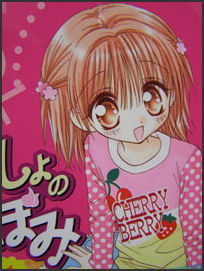
“Kawaii” (“cute”) has been an obsession in Japan since the 1960s. Young girls into this look in an extreme sense wear fake fur short coats, have angel wings attached to their backs, have little teddy bears dangling from cell phones and adore anything associated with Mickey Mouse and Pooh-san (Winnie the Pooh). There is an entire magazine called “Cutie” devoted to the “kawaii” look.
Kawaii manifests itself in Japanese anime on television, on road signs with warm and fuzzy bunnies and racoons, and in a seemingly nationwide infatuation with Mickey Mouse and Disney. And its not just a girl and kid thing. Salarymen decorate their cubicles with pictures of teenage idol singers. Shinto shrines sell Hello Kitty key chains. Even the black Mercedes of yakuza gangster have things like a row stuffed Poohs on the dashboard. Some say the Japanese obsession with kawaii began with a Japanese fascination for Petty Boop and really took off with idoloziaion of the American figure skater Janet Lynn.
One reader wrote into the Daily Yomiuri: “To be called cute is a high complement. Cute is cute because its looks harmless but on a deeper level is subordinate. Japan’s love for cute things has been internalized by women and demonstrated in their looks and actions. Because of this, life for women is full of day-to-day and lifelong compromises...Is cute all women are expected to be in Japan? More importantly, is that all they want to be?” “Uru-kyara” means “cute, relaxed and unsophisticated.”
The Japanese Foreign Ministry chose model Misako Aoki, singer Yu Kimura and actress Shizuja to be “Kawaii taishi” (“Cute ambassadors”) to promote Japanese pop and kawaai culture abroad. In promotional appearances Aoki is dressed like a Lolita and Fujioka is clad in schoolgirl uniform.
See Manga
“Y
Popular Japanese Culture Abroad
Pop culture tours of Japan sponsored by U.S.-based Pop Japan Travel includes a stop at Tsukiji fish market, a tea ceremony in Ginza, a ride on the Sumida River to Odaiba on the Himiko water bus (designed by manga legend Leiji Matsumoto), sampling virtual reality rides ay the Sega Joyopolis, chatting with famous manga artists and anime art directors, and bathing with :friendly otaku,”
Japanese fashion, anime and manga are popular in Paris. There are manga cafes and boutiques that sell kawaii cute fashions there. The ninth Japan Expo in Paris in 2008 was held in a space twice the size of the Tokyo Dome. More than 130,000 people showed up.
Japan cool culture has made its presence known in New York. Japan Day in New York’s Central Park has been staged since 2005 and draws thousands of people. Tokyo Bar is new bar in Soho in New York with manga on the walls, sochu and approximations of Shinjuku. Kinokuniya, one of Japan’s biggest bookstore chains, has large branch Manhattan. Fashions by Nigo and Bathing Ape are popular with fashionistas.
The Kennedy Center in Washington hosted a “Japan: Culture and Hyper Culture” show. Pokemon appeared in theMacy’s Parade. Ultraman remains popular on television. Puffy has won new converts to Japanese pop culture.
Japanese music and fashion are very big in Asia, particularly Taiwan. See China, Korea, Taiwan
Japanese Fads in the 1960s, 70s and 80s
Cultural icons in the 1960s (some of which are still around) included Astro Boy, Ultraman, Dakko-chan (an inflatable rubber doll popular with 5-year-olds), Tora-San (an endearing salesman played by the late Kyoshi Atsuma in 48 films). Peko-chan, the pig-tailed Fujiya bakery girl, dates back to the 1950s.
Among enduring fads from the 1970s were the panda Lan-Lan and Kan-Kan, the walkman, karaoke, Doraemon (an animated blue cat loved throughout Asia) and the Pink Ladies (a pair of women who sang corny pop songs in sequined outfits before large crowds).
Fads in the 1980s included Super Mario (the character that helped make Nintendo the world's largest video game maker); Hello Kitty (a cutesy cat logo featured on a large array of merchandise); Asahi dry beer, and capsule hotels.
Japanese Fads in the 1990s
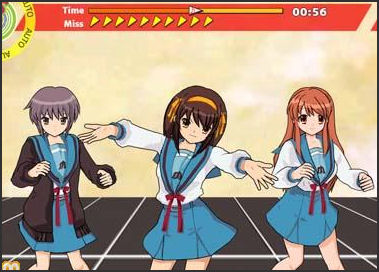
dance game Among the noteworthy trends in the 1990s are Tamagotchi virtual pets, Julianas (a Tokyo club where office ladies dance on a platform while salarymen looked up their skirts); Print Clubs (photo machines that produce stickers with different backgrounds and characters), and Dance machines.
“Purikura” (Print Club) is a curtain stall where you can have a photo taken with eight friends and have eight sticker-prints made with a decorative border of your choosing. A sheet cost about $3.50, two cost $5. They were very popular in the late 1990s and still popular today. Some young girls have hundred of them.
One of the biggest fads in the mid-1990s was “Ruusu sokkusu” (“loose socks”), baggy knee-high socks worn by schoolgirls and held in place with special glue that was applied with a deodorant-like roller stick. In one survey, 81 percent al all school girls interviewed said they had worn the socks at one time. Other clothing fads from the same period included platform sneakers, knee-high boots, and glued on bras.
Japanese Fads and Schoolgirls
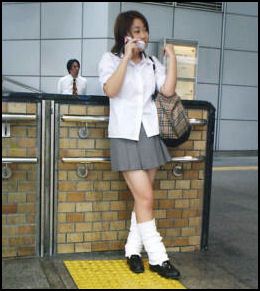
Ruusu sokkusu The biggest trendsetters — and fashion slaves — in Japan are teenage schoolgirls. They make up only four percent of the population but have a surprising amount of marketplace clout and a lot of cash to throw around. According to one study 68 percent of all Japanese teenagers receive a monthly allowance of $300 or more (compared to only 28 percent for American youth). They also receive regular "six pocket" cash gifts from their two parents and four grandparents. While boys tend to spend their money on video games, girls spend their on the latest fashions.
As one 17-year-old girl told the Los Angeles Times, "We want to be cute. We want to have fun. We like the same things." Most girls have cell phones and if they see something they like they can spread the word quick. Some companies have even hired girls to spread the word about new products by telling their friends to keep it a secret.
Fads travel very fast in the schoolgirl community. If a product is really hot it can spread in less than a week. If five percent of the girls like something 60 percent can be into it in a month.
Tamagotchi Virtual Pets
Tamagotchi virtual pets were very popular worldwide in the late 1990s and made a brief come back in Japan in the mid 2000s. Endearing to some, annoying to others, these egg-shaped and egg-sized computer games had to be "fed," "played with," "cleaned" and "scolded" by their owners who punching buttons below a small liquid-crystal screen with a picture of a chicken. If the toy wasn't fed or taken care of at the proper time the Tamagotchi started peeping and the "peep, peep, peep" got louder and longer until the pet was taken care of by its owner. Tamagotchi means "cute little egg."
The lifespan of the virtual pet was a maximum of about 15 days. The toy "died" of its was unattended for more than five of six hours during the day (at night it could be put to sleep by pushing a button). After its death, a happiness meter gauged the owners patenting skills. In addition to the chicken, there were Tamagotchi puppies and dinosaurs that hatched from an egg like the chicken.
More than 40 million Tamaguchi were sold in two years. In the mid 2000s, a new version called Tamagotchi Plus was introduced. It could befriend and mate with others of its kinds. They sold for about $20 but were seen as out of date because they only had monochrome screens in a world dominated by consoles and had held games with fancy color graphics.

Marketing Tamagotchi Pets
Almost immediately after it was introduced in 1997 in Japan it was a big hit: people slept in the cold outside stores to be first in line for new shipment, some shops sold $9 lottery tickets for the opportunity to buy the $18 toys, a temple in Hiroshima opened up "virtual cemetery" for dead virtual pets, and a 24-hour hotline was set up to console children who lost their pets.
According to one story the virtual pet was invented by Akihiro Yokoi, the owner of a toy consulting company call the Wiz Company. He said he got the idea when he saw a television commercial with a mother scolding a boy about the care of his pet turtle. Yokoi designed the toy for the Japanese toy manufacturer Bandai Company.
According to another account Tamagotchi was invented by a 26-year-old woman named Aki Komikado who worked at Bandai. She hatched the idea in 1994 based on the concept that people love pets. Even though she earned her company $350 millon, she didn't receive a raise or a big bonus. But that didn't seem to bother her much. "Why should I get lots of money? "She told Time. "The real efforts was made by the developers who made our products successful."
Profits and Problems with the Tamogotchi
Seven million virtual pets were sold in Japan within a few months after it was introduced and millions more were sold overseas. One store said it sold 30,000 in three days and one mail order company that advertised on television said it sold 6,000 in five minutes. The toy was so popular hundreds of thousands of counterfeit copies and look alike imitations flooded the market. As of 1997, about 20 million Tamagotchi had been sold in Japan alone.
Around the world the Tamagotchi were banned by teachers and educators, who found they toy's peeping to be annoying and distracting to the students and themselves. One teacher in Hong Kong told AFP, "How can students concentrate. They have to fed, clean the dropping and play with their pets even during lessons."
In Japan, there was a rash of virtual pet thefts from school backpacks and they were even reports of dirty old men using the to toys to lure young schoolgirls. Some psychiatrist also complained that some young children became traumatized when their virtual pets died.
Love Beeper
The big fad among schoolboys and schoolgirls and young men and young women in 1998 were Lovegetys, palm-size beepers with a range of about 15 feet that could used to send a "love beep" to someone nearby with a similar devise. The $22 gadget was trumpeted as a way for notoriously shy Japanese to meet members of the opposite sex.
Ideally the device worked like this: a guy is in a park sees an attractive girl so press his Lovegety (as in "get love") to send a love beep to the girl. of the girl doesn't have a Lovegety he is out of luck. But if she has one, and she sends back a beep, that means she is open to suggestions, all they have to do next is talk to one another. Needless to say the idea never really caught on.
Many Japanese school kids meet people by randomly dialing numbers on their cell phones. School kids often stick their parents with $100 to $200 a month phone bills.
Western Culture in Japan
Japan is considered the most Westernized nation in Asia. Some Japanese are Anglophiles, with a love for English tea, Winnie the Pooh, Shakespeare, Burberry Scarves, and Laura Ashley; some are Francophlines, with a love for French food, wine, pastries and Louis Vuitton bags; others love Italian style, Prada handbags, Gucci fashions; and still others go in for things American, McDonald’s, Disney, grunge rock, fifties doo-wop, The Ventures, Nikes and Levis.
The Japanese are infatuated with Audrey Hepburn that you can see “Love in the Afternoon, Roman Holiday” or “Sabrina” almost any day of the week somewhere in Tokyo. She appears regularly on television. The novel: “Audrey Hepburn's Neck” by Alan Browne sild well in Japan,
English culture has made inroads into Japan. Harrods has 60 outlets in Japanese department stores, Austin Minis are collectors items and English gardening is popular.
Lowriders in Japan

lowrider rocket van Lowriders, street-hugging cars with hydraulic lifts that are popular among the Latin and black communities in Los Angeles is one of the oddest American fads to catch on in Japan. A typical 1960s Chevy Impala outfit with a lowriding suspension that can make a car jump and down sells for $5,000 to $15,000 in the U.S., but goes for between $25,000 and $35,000 in Japan.
The popularity of lowriders is a result of the importation of rap culture, whose videos often feature low riders. The number of lowriders has increased from 300 in 1992 to 3,000 in 1996. The are clubs, shops, and magazines geared towards lowrider enthusiasts. Brokers who import low-riders from California to Japan say they make about $2,000 on each vehicle.
Many lowrider vehicles are too big for Japan's roads. You rarely see them on the streets and owners need to have them trucked to lowrider gatherings. Many lowrider enthusiasts are blue collar workers who are fascinated by American lowrider culture.
Snowboarding and Surfing in Japan
Surfing is popular in Japan. Some surfing beaches are on one side of a highway with ugly concrete highrises on the other. Surfing is also a fashion with many surfers seeming more interested in accessories than the sport. The same can said about skateboarding, where dressing the part oftem has precedence over skateboarding ability.
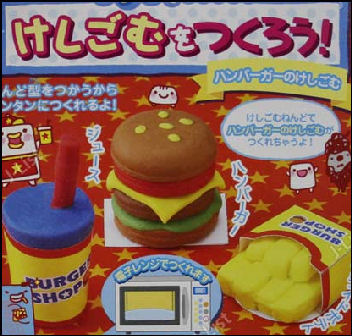
fast food erasers There are around 600,000 certified scuba divers in Japan. The fatality rate among scuba divers is failry high in Japan. A total of 182 divers died between 1999 and 2007. In one case two divers died on a single dive off the Amami islands in Kagoshima Prefecture after becoming separated from their group. The scuba instructor it turned out never held a diver’s license, let along a diving instructor’s license, He was sentenced to 16 months in jail for professional negligence.
In the mid-1990s, snowboarding caught on with Japanese youth in a big way. Snowboarders became a fixture of television commercials, stores carried a dozen or so specialty snowboarding magazines, and number of snowboarders jumped from 200,000 in 1992 to 800,000 in 1996 to 5.4 million in 2000 and has remained steady for several years, before dropping off.
Japan now accounts for 20 to 30 percent of the $800 million annual global snowboarding industry. A typical Japanese snowboarders not only dishes out $500 for a snowboard he or she also spends up to $1,000 on the prerequisite snowboarder outfit: baggy pants, thick-soled sneakers, baseball caps, and formless windbreakers.
Image Sources: 1) 6) 8) 11) 13) Ray Kinnane; 2), 4) 5), 7), 8), 9), 10) 11), 12) xorsyst blog; 3) Japan Visitors
Text Sources: New York Times, Washington Post, Los Angeles Times, Daily Yomiuri, Times of London, Japan National Tourist Organization (JNTO), National Geographic, The New Yorker, Time, Newsweek, Reuters, AP, Lonely Planet Guides, Compton’s Encyclopedia and various books and other publications.
Last updated January 2013
